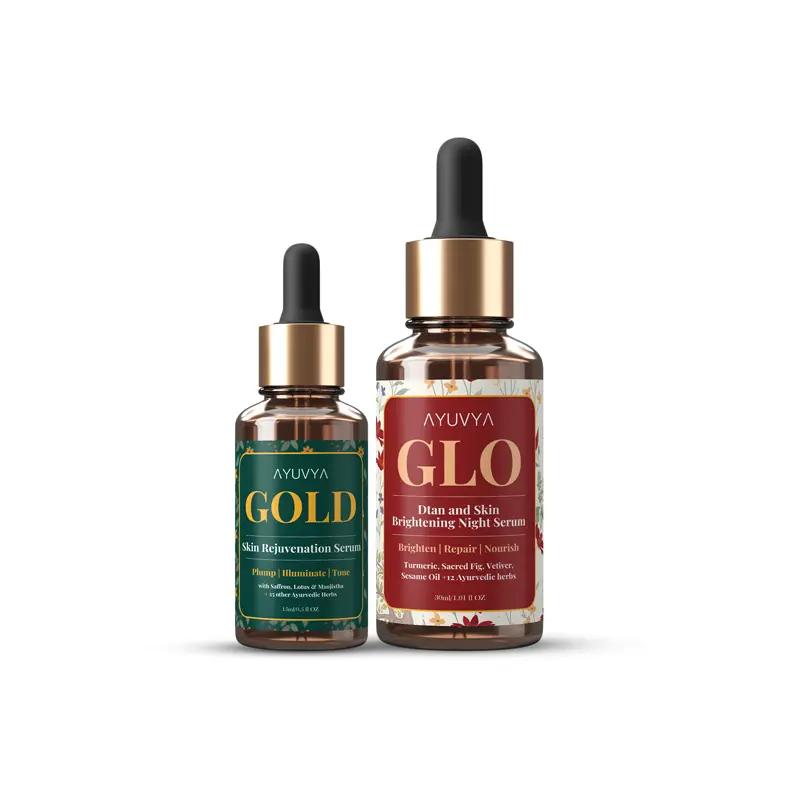Sandalwood Oil Benefits for Skin and Hair
Jul 18, 2024

Sandalwood, or Chandan in Ayurveda, has been cherished in ancient India for thousands of years due to its therapeutic and spiritual properties. Sourced from the Santalum tree, sandalwood oil is recognized for its benefits for both skin and hair in traditional practices.
Table of Contents:
- Sandalwood Oil Benefits for Skin: Skin Whitening, Acne Scars, and More for a Radiant Face
- Sandalwood Oil for Skin Whitening
- Sandalwood Oil for Acne Scars
- Sandalwood oil benefits for hair
- How to Use Sandalwood Oil?
- Conclusion
- FAQs
In Ayurveda, sandalwood is considered a cooling, astringent, and antiseptic herb. It is highly valued for its calming effects on the mind and body, making it a vital component in meditation and spiritual rituals. Its fragrance is thought to promote tranquillity, improve concentration, and enhance spiritual awareness.
Sandalwood has diverse uses in Ayurvedic medicine. Its oil is effective for acne scars and eczema due to its anti-inflammatory and antiseptic properties. Additionally, it aids digestion and promotes overall wellness through herbal formulations and pastes.
Historically, sandalwood has played a significant role in religious ceremonies in India, often used to create sacred objects like rosary beads and idols, symbolising purity and devotion. The preparation of sandalwood paste for puja (worship) highlights its spiritual importance.
Sandalwood oil is also utilised for skin whitening and tan removal, making it a vital part of Ayurvedic practices. Celebrated for its healing qualities, sandalwood essential oil remains essential to Indian grooming culture, connecting users to a deeper sense of peace and spirituality.
Sandalwood Oil Benefits for Skin: Skin Whitening, Acne Scars, and More for a Radiant Face
Sandalwood essential oil benefits for skin include a range of advantages:
-Antimicrobial effects
-Antiproliferative qualities, which help prevent unwanted cell growth
-Antiviral benefits
-Antiseptic characteristics
-Fever-reducing effects
-Scabies-inhibiting properties
The primary active component in sandalwood oil is alpha-santalol, which is effective against bacteria and yeast.
Sandalwood oil may assist with:
-Scarring
-Inflammation
-Wound healing
-Acne
-Achieving an even skin tone or skin lightening
As this versatile oil has been used for various skin conditions, it highlights the benefits of sandalwood oil for the skin.
Sandalwood Oil for Skin Whitening
Sandalwood oil contains alpha-santalol, a compound known for its anti-inflammatory and antibacterial properties. This helps reduce skin irritation and blemishes, contributing to a more even skin tone. By calming inflammation, sandalwood oil minimises the appearance of dark spots and redness, allowing the skin to appear clearer and brighter.
Second, sandalwood oil acts as a natural exfoliant, helping to remove dead skin cells that can accumulate on the surface. This exfoliation process reveals healthier, more radiant skin underneath. Regular use can lead to a smoother texture and enhanced luminosity.
Additionally, sandalwood oil is often used in combination with other natural ingredients, such as honey, lemon juice, or yogurt, to create effective face masks. These mixtures can further enhance sandalwood oil for its skin whitening effects while providing hydration and nourishment.
To use sandalwood oil for skin whitening, mix a few drops with a carrier oil or incorporate it into a face mask. Applying it regularly can help achieve a brighter, more even complexion over time.
However, it’s essential to conduct a patch test first to ensure there are no adverse reactions, particularly for sensitive skin types. Overall, using sandalwood oil for skin whitening is a gentle yet effective option for those seeking a natural approach to skin whitening.
Sandalwood Oil for Acne Scars
The primary active ingredient in sandalwood oil, alpha-santalol, possesses strong anti-inflammatory and antimicrobial properties. Sandalwood oil for acne scars help reduce redness and inflammation associated with acne, while also preventing future breakouts. By soothing the skin, sandalwood oil aids in minimising the appearance of scars.
To use sandalwood oil for acne scars, mix a few drops with a carrier oil, such as jojoba or coconut oil, and apply it directly to the affected areas. Alternatively, you can create a face mask by combining sandalwood powder with water or yoghurt. Consistent use can help fade scars and promote healthier skin, making sandalwood oil a valuable addition to any skincare routine targeting acne scars.
Sandalwood oil benefits for hair
Promotes a Healthy Scalp
-Antimicrobial properties combat dandruff and scalp infections.
-Creates an optimal environment for hair growth.
-Essential for preventing hair loss and promoting overall hair vitality.
Deeply Nourishes and Moisturizes Hair
-Lightweight texture allows for easy absorption.
-Ideal for dry or damaged hair.
-Restores moisture, leaving hair soft, smooth, and manageable.
Natural Anti-Frizz Agent
-Tames unruly hair by smoothing hair cuticles.
-Reduces frizz and enhances shine.
-Particularly beneficial for curly or wavy hair types.
Promotes Hair Growth
-Massaging the oil into the scalp stimulates blood circulation.
-Encourages healthier and stronger hair follicles.
-Adds volume and thickness to the hair.
How to Use Sandalwood Oil
-Mix a few drops with a carrier oil.
-Add it to your shampoo or conditioner.
-Use as a pre-shampoo treatment or leave-in conditioner for optimal results.
How to Use Sandalwood Oil?
Sandalwood essential oil benefits are versatile and can be easily incorporated into your daily routine. If you’re wondering how to use sandalwood oil, here are several effective methods to maximise its benefits for skin and hair.
1. Facial Masks: One popular way to learn how to use sandalwood oil is by creating a soothing face mask. Mix a few drops of sandalwood oil with yoghurt or honey to form a paste. Apply it to your face for 15-20 minutes, then rinse off with warm water. This helps brighten the skin and reduce acne scars.
2. Dilution for Massage: For a relaxing massage, mix sandalwood oil with a carrier oil, such as coconut or jojoba oil. This is a great method for learning how to use sandalwood oil for stress relief and skin hydration. Massage it into your skin or scalp to promote relaxation and nourishment.
3. In Hair Care: If you're looking for how to use sandalwood oil for hair, add a few drops to your shampoo or conditioner. This not only enhances the fragrance but also helps with dandruff and scalp health. Alternatively, you can create a hair mask by mixing sandalwood oil with olive oil and applying it to your scalp.
4. In Aromatherapy: Another excellent way to explore how to use sandalwood oil is through aromatherapy. Add a few drops to a diffuser to enjoy its calming aroma, which can help reduce stress and anxiety.
5. Bath Soak: For a luxurious bath experience, mix sandalwood oil with Epsom salts and add it to your bathwater. This method is an excellent example of how to use sandalwood oil for relaxation and skin nourishment.
By following these methods, you can easily incorporate sandalwood oil into your home care routine for radiant skin and healthy hair.
Conclusion
Incorporating these sandalwood essential oil benefits into your skincare and haircare routines can elevate your beauty regimen. With its rich history, sandalwood essential oil benefits include anti-inflammatory properties that help reduce acne scars and moisturising effects that promote healthy hair.
Using sandalwood essential oil effectively, whether in facial masks, scalp treatments, or aromatherapy, unlocks its transformative potential. Regular use of sandalwood essential oil for skin aids in healing and fosters overall well-being. Embrace sandalwood essential oil benefits for skin to connect with nature and enhance your beauty. Make sandalwood essential oil a staple in your daily routine for lasting results.
Frequently Asked Questions
Disadvantages of sandalwood oil include potential skin irritation, allergic reactions, interactions with certain medications, and its high cost. Overuse may also lead to dryness or sensitivity in some individuals.
Yes, sandalwood can be applied to the face daily. It helps soothe skin, reduce inflammation, and improve complexion, but always perform a patch test to avoid irritation.
To apply sandalwood oil to hair, mix a few drops with a carrier oil, massage it into the scalp, leave for 30 minutes, then wash out with shampoo.
Yes, sandalwood oil can help brighten skin and improve complexion due to its anti-inflammatory and antioxidant properties, promoting an even skin tone and reducing dark spots over time.
Yes, you can apply sandalwood oil directly on the skin, but it's advisable to dilute it with a carrier oil to prevent irritation, especially for sensitive skin.
















